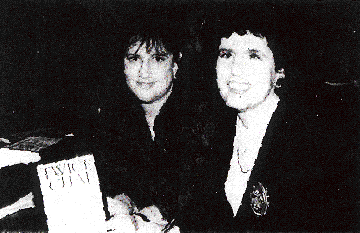
Marcia Hain of Woodmere (right), author, and Sherry Reiter (left), social worker, spoke to the members of Hewlett Hadassah about topics often avoided in Jewish communities.
Nassau Herald
April 1992
Breaking Silence in the Jewish Community
By Cynthia J. Hoffman

"Silence," said Sherry Reiter, "doesn't lie, but it doesn't tell the truth either."
Ms. Reiter, a social worker who uses drama and poetry in therapy, and Marcia Hain, author of the book "Twice Chai: A Jewish Road to Recovery" addressed the members of the Hewlett Hadassah at a March 24 lecture entitled "Breaking the Silence Taboo Topics in the Jewish Community."
Ms. Reiter, creator of the guidelines for "Twice Chai ...", a book of inspirational poems designed to help those in some form of recovery, said the reason that some topics are left unspoken is because of the stigma that is attached to them. When someone hears that another is involved in an accident, most people feel sympathetic; however, when one is told that someone has an addiction or has AIDS, one tends to feel that those people have brought the problem on themselves, she pointed out. They become a guilty victim, she said.
Through an audience participation exercise, Ms. Reiter attempted to establish that "nobody is perfect and no one always does the right thing...we aren't always in control of what happens...a victim is a victim."
Speaking to others about personal tragedy and suffering is difficult in the Jewish community, said Ms. Reiter, because image is more important to Jews than to other groups. Throughout history, "Jews had to be accepted wherever they went. Their lives depended on it," and the importance of image has carried over from the past, she said.
Denial is a typical human reaction when another individual is in pain or fear, according to Ms. Reiter. "Denial draws lines or boxes that separate them from us." Many people, she said, do not think that AIDS is a Jewish problem, yet there are names like Schwartz and Horowitz embroidered on panels of the AIDS quilt. Nor do they think that child abuse exists in Jewish families, but perhaps the most famous case of abuse was committed by Joel Steinberg and Hedda Nussbaum, she added.
Jewish communities have to address problems such as addictions, said Ms. Reiter. Over 30 percent of all Alcoholics Anonymous members in Manhattan chapters are Jews, she noted. "It is difficult for synagogues to host Alcoholics Anonymous or Narcotics Anonymous meetings or to get help from a rabbi about drug abuse."
Marcia Hain of Woodmere, who experienced first-hand the ordeal of having a family member addicted to drugs, said that people must reach out and help each other and be sensitive to the suffering of others.
"More people need to come out and share their experiences" so that addictions and abuse can be "destigmatized, and people can face their problems and get help."
Those in distress wonder if they will ever be "whole again," said the author. Although "the scars never go away, our wounds enable us to reach out to others."
Ms. Hain said that "Judaism is full of new beginnings," and that "with God's help" a person in recovery can make a new life for his or her self.
"None of us," she said, "is immune to despair and hopelessness..."